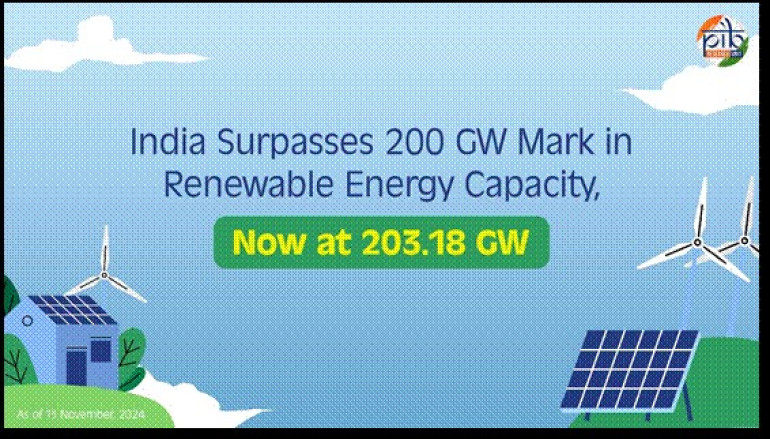
Follow India Renewable Energy News on WhatsApp for exclusive updates on clean energy news and insights
India’s Renewable Energy Capacity Reaches 214.68 GW, Government Targets 500 GW by 2030
Mar 16, 2025
In a reply given to Lok Sabha Parliament by the Ministry of New & Renewable Energy (MNRE), India has made significant progress in renewable energy expansion, reaching a total installed capacity of 214.68 GW as of February 28, 2025. This includes 102.57 GW of solar power, 48.59 GW of wind power, 11.45 GW of bio-power, and 52.07 GW of hydro power.
Government Initiatives to Achieve 500 GW Non-Fossil Capacity by 2030
The Indian government has launched several policies and programs to accelerate renewable energy deployment, including:
- 50 GW Annual RE Bidding Trajectory (FY 2023-24 to 2027-28): Issued by MNRE for large-scale procurement through Solar Energy Corporation of India (SECI), NTPC, NHPC, and SJVN.
- 100% Foreign Direct Investment (FDI): Allowed under the automatic route to attract global investments.
- ISTS Charge Waivers: Waived for solar and wind projects until June 2025, green hydrogen projects until December 2030, and offshore wind projects until December 2032.
- Renewable Consumption Obligation (RCO): Ensures penalties for non-compliance and mandates consumption of Decentralized Renewable Energy (DRE) sources.
- New & Upgraded Transmission Infrastructure: Expansion under the Green Energy Corridor Scheme to ensure smooth RE power evacuation.
- Offshore Wind Energy Initiatives:
- Strategy for Offshore Wind Projects with a 37 GW bidding trajectory by 2030.
- Offshore Wind Energy Lease Rules, 2023 introduced to regulate leasing for project development.
- Solar Energy Programs:
- PM-KUSUM & PM Surya Ghar Muft Bijli Yojana for decentralized solar installations.
- National High-Efficiency Solar PV Modules Program to boost domestic manufacturing.
- New Solar Power Scheme for Tribal & PVTG Villages under PM JANMAN.
- Green Energy Market Reforms:
- Green Energy Open Access Rules, 2022 for consumers with a contract demand of 100 kW or more.
- Green Term Ahead Market (GTAM): Enables RE power trading via energy exchanges.
- Timely Payment Mechanism: Power purchase payments must be backed by Letter of Credit (LC) or advance payments to ensure financial stability for RE developers.
Budgetary Allocation for Renewable Energy (Last Five Years)
The MNRE’s financial allocations have steadily increased to support India’s energy transition:
- 2019-20: Rs 3,891.74 crore
- 2020-21: Rs 3,591.00 crore
- 2021-22: Rs 7,681.80 crore
- 2022-23: Rs 7,033.00 crore
- 2023-24: Rs 7,848.00 crore
India remains committed to achieving 500 GW of non-fossil energy capacity by 2030, backed by strong policies, investment-friendly reforms, and technological advancements. With expanding solar, wind, and green hydrogen initiatives, the country is poised to become a global leader in clean energy.